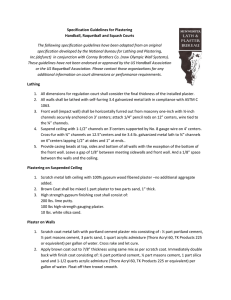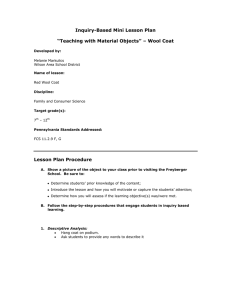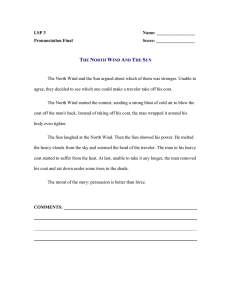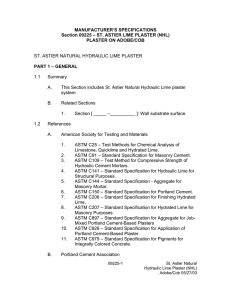Plaster on Straw Bale Construction - Saint Astier® Natural Hydraulic
advertisement
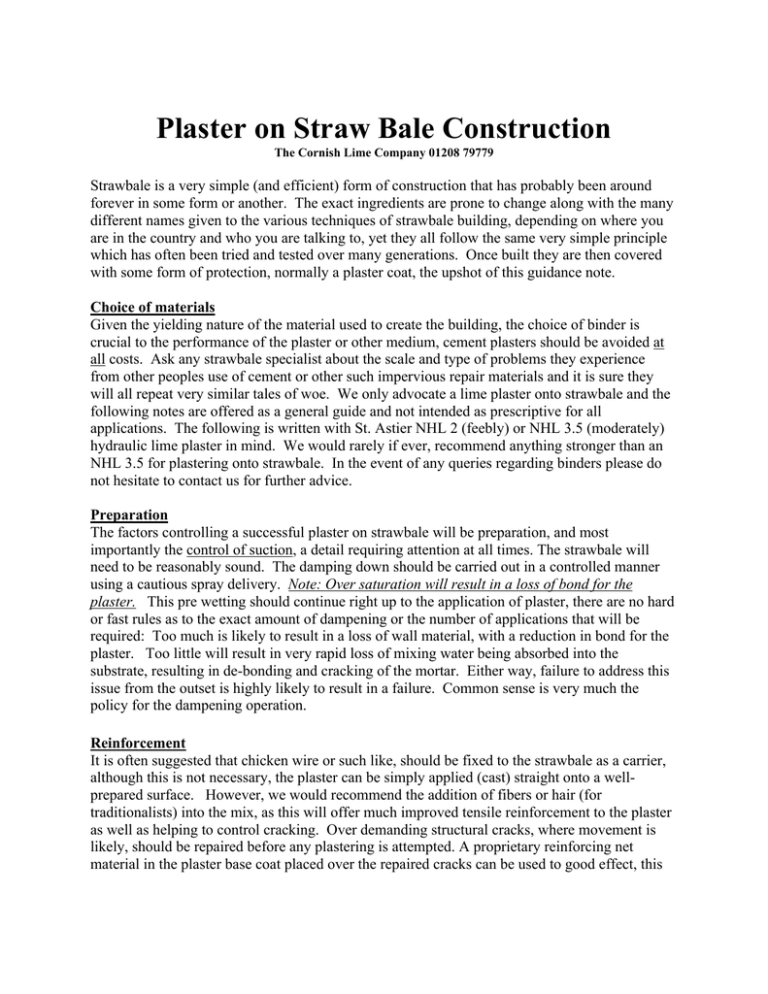
Plaster on Straw Bale Construction The Cornish Lime Company 01208 79779 Strawbale is a very simple (and efficient) form of construction that has probably been around forever in some form or another. The exact ingredients are prone to change along with the many different names given to the various techniques of strawbale building, depending on where you are in the country and who you are talking to, yet they all follow the same very simple principle which has often been tried and tested over many generations. Once built they are then covered with some form of protection, normally a plaster coat, the upshot of this guidance note. Choice of materials Given the yielding nature of the material used to create the building, the choice of binder is crucial to the performance of the plaster or other medium, cement plasters should be avoided at all costs. Ask any strawbale specialist about the scale and type of problems they experience from other peoples use of cement or other such impervious repair materials and it is sure they will all repeat very similar tales of woe. We only advocate a lime plaster onto strawbale and the following notes are offered as a general guide and not intended as prescriptive for all applications. The following is written with St. Astier NHL 2 (feebly) or NHL 3.5 (moderately) hydraulic lime plaster in mind. We would rarely if ever, recommend anything stronger than an NHL 3.5 for plastering onto strawbale. In the event of any queries regarding binders please do not hesitate to contact us for further advice. Preparation The factors controlling a successful plaster on strawbale will be preparation, and most importantly the control of suction, a detail requiring attention at all times. The strawbale will need to be reasonably sound. The damping down should be carried out in a controlled manner using a cautious spray delivery. Note: Over saturation will result in a loss of bond for the plaster. This pre wetting should continue right up to the application of plaster, there are no hard or fast rules as to the exact amount of dampening or the number of applications that will be required: Too much is likely to result in a loss of wall material, with a reduction in bond for the plaster. Too little will result in very rapid loss of mixing water being absorbed into the substrate, resulting in de-bonding and cracking of the mortar. Either way, failure to address this issue from the outset is highly likely to result in a failure. Common sense is very much the policy for the dampening operation. Reinforcement It is often suggested that chicken wire or such like, should be fixed to the strawbale as a carrier, although this is not necessary, the plaster can be simply applied (cast) straight onto a wellprepared surface. However, we would recommend the addition of fibers or hair (for traditionalists) into the mix, as this will offer much improved tensile reinforcement to the plaster as well as helping to control cracking. Over demanding structural cracks, where movement is likely, should be repaired before any plastering is attempted. A proprietary reinforcing net material in the plaster base coat placed over the repaired cracks can be used to good effect, this approach is very subjective with differing criteria or factors relevant to each situation and further advice should be taken if it is an unfamiliar technique. Thickness of Plaster The thickness of the plaster should be determined by such factors as location, exposure and other relevant points that are likely to have a bearing. Different buildings will have different criteria, with all factors requiring consideration prior to determining the plaster thickness. Application First Coat (Scratch Coat) 1 : 1.5 Lime (NHL 3.5) : Sharp Sand / 1 : 2 Lime (NHL 3.5) : Sharp Sand Prior to the scratch coat being applied any depressions or hollows requiring dubbing out should be carried out using a 1: 1.5 mix with NHL 3.5 or 1:2 with NHL 3.5 and allowed sufficient time to set 7 days minimum, longer if dubbing out is deep, provide adequate keying to dubbing out. The scratch coat should be cast on (sprayed, harled, spatter dash, roughcast), thus improving the bond between plaster and substrate, at a thickness of 1/2” in one pass to 3/4” in two passes, well mixed to a consistency to suit the desired method of application. (Spray application is a stiffer mix than hand thrown) The grit in a good sharp sand will improve the performance of the plaster and left rough act as a key for the subsequent plaster coat to hang on to. The physical action of casting on a base coat offers a much improved bond, both physically and mechanically being a simple yet effective means of application (however, achieving a uniform cast on top coat is a skilled operation) once applied this bonding coat should be left alone for a minimum of 7-10 days and cured properly by covering to exclude direct sunlight and drying winds. Cure by misting with clean water several times a day, if necessary. Keying: Adequate keying between background, base and each coat is important. This is best achieved by providing a crisscross pattern in the region of a 2” diamond pattern over the wall areas. Crisscross is more suitable than the contemporary combing or rough brushing of a wall in respect of lime plasters. (Do not cut too deeply) Second Coat (Brown coat) 1 : 2 lime (NHL 3.5) : sharp sand / 1 : 2.5 lime (NHL 3.5) : sharp sand The second coat should not be applied for at least 7-10 days (or more, depending on atmospheric conditions) after completion of the first coat. Once again pre wetting is very important prior to application.. Apply using firm and even pressure, if using a laying on trowel for application, the coat thickness should be even and once applied should not be overworked. In simple terms “lay it up and leave it alone.” As for all plastering, the coats should be getting slightly weaker or thinner away from the wall with the mix for this coat at 1 : 2 (NHL 3.5 to sand), or 1 : 2.5 (NHL 3.5 to sand) : sharp sand and of a thickness not exceeding 3/4” (15 mm) (in two passes when thickness exceeds 1/2”), on completion adequate protective and curing measures should be put into place. Any initial shrinkage taking place in the drying out phase can be rubbed back by using a wood plasterers float and by dampening the affected area again, this will need to be carried out within the first 24 hours. Press the float home evenly and firmly in a close circular motion. Proper protection, the addition of reinforcing along with regular humidifying (using a fog mist spray), will all greatly reduce the amount of shrinkage likely to take place. Do not work in temperatures above 85oF or below 40oF and never when frost is forecast during the curing period. Top Coat (Finish coat) 1 : 2.5 Lime (NHL 2) : Sharp Sand / 1 : 3 lime (NHL 2) : sharp sand The final coat should be treated much the same as for the previous coats assuming all straightening required, has been carried out and all objectives for the base coats have been dealt with. The most beneficial and traditional finish for strawbale is roughcast (harling, spatter dash) and this should be carried out by operatives skilled in its application. Most importantly the thickness of the final topcoat is crucial and should not be applied any greater than 3/16” to 5/16” (5-8 mm). Protect and cure, leaving it for as long as is practically possible 7-10 days, longer if the weather dictates. Overworking mortars results in free lime and fines being pulled to the surface thus affecting the properties and visual appearance of the work. The choice of sand in the top coat is important, dependent on the finish required, however a roughcast finish will require a sharp sand, smoother finishes require well graded fine sharp sands, silt and clay free. Curing: This will be best achieved using a suitable protective sheathing applied to the scaffold sufficient in its capacity to minimize direct sunlight and wind drying of the surface. This can and often should be further supplemented, with a damp Burlap type sacking draped over the face of the plaster to further protect and inhibit any accelerated loss of moisture from taking place. Additional protection could be offered from a fog mist spray delivered by pump up sprayer or equal on a regular a basis until the work is adequately cured. Sharp Sand Our definition of good sharp sand will be one that is both sharp (jagged) and well graded within its size parameters from #5 to #200 (4 mm to 70 micron). (See Sands for NHL mortars)

